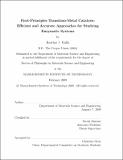| dc.contributor.advisor | Nicola Marzari. | en_US |
| dc.contributor.author | Kulik, Heather J | en_US |
| dc.contributor.other | Massachusetts Institute of Technology. Dept. of Materials Science and Engineering. | en_US |
| dc.date.accessioned | 2009-08-25T18:01:40Z | |
| dc.date.available | 2009-08-25T18:01:40Z | |
| dc.date.copyright | 2009 | en_US |
| dc.date.issued | 2009 | en_US |
| dc.identifier.uri | http://hdl.handle.net/1721.1/46389 | |
| dc.description | This electronic version was submitted by the student author. The certified thesis is available in the Institute Archives and Special Collections. | en_US |
| dc.description | Thesis (Ph. D.)--Massachusetts Institute of Technology, Dept. of Materials Science and Engineering, 2009. | en_US |
| dc.description | Includes bibliographical references (p. 211-221). | en_US |
| dc.description.abstract | (cont.) We apply our approach to several paradigmatic systems: spin state splittings and structural properties of Fe2 and other small molecules as well as the addition-elimination reactions of hydrogen and methane on FeO+ to form water and methanol, respectively. We find that errors from common density functionals which are over 1.0 eV are greatly reduced to on average 0.1 eV when the DFT+U approach is implemented as compared against experiment and highly accurate but expensive quantum chemistry. We also improve structural and vibrational properties, ground state spin identification for a given configuration, and qualitative descriptions of reaction mechanism. Thanks to the minimal overhead of our DFT+U approach, we have also studied properties of systems of over one thousand electrons in size: in particular, the spin density profiles of functionalized cobalt porphyrins on a metal slab support and the reaction mechanism of the halogenating non-heme Fe(II) enzyme, SyrB2. Efficient and accurate study of transition metal chemistry paves the way for predictive and targeted design of catalysts that provide unique solutions for green chemistry and optimal harnessing of alternative energy sources. | en_US |
| dc.description.abstract | Transition metals are ever-present as reactive centers in biological and inorganic catalytic cycles. However, the open shell character which gives 3d transition metals unique reactive properties also makes transition metal complexes challenging to study using traditional first principles approaches. Density functional theory is a widely popular computational approach because it recasts a many-body problem of interacting electrons into an equivalent problem of non-interacting electrons, greatly reducing computational cost. Each electron lives in the electric field of the total electron density, giving rise to a problem known as self-interaction; that is, each electron sees the total field including itself, and is therefore repelled by itself. Such an error is maximal in systems with highly localized electrons, in particular transition metals. We introduce an approach in which we augment standard density functionals with a Hubbard U term that helps to counteract the unphysical delocalization of electrons due to errors in exchange-correlation functionals. A Hubbard U approach has already been successfully applied to highly correlated systems in the solid state, but we introduce it for the first time to study the transition metal centers of molecules. This approach, we will show, is even more fitting for single-site molecules where the Hubbard U term need only counteract local effects (e.g. excessive hybridization with ligands) as opposed to multi-site systems where both short-range and long-range self-interaction problems are simultaneously present. The simplified, linear-response formulation we use in conjunction with density functional theory permits direct calculation of the Hubbard U, which is an intrinsic property of the system. We also extend this DFT+U approach by obtaining the linear-response U self-consistently as a property of the DFT+U density, further increasing accuracy. | en_US |
| dc.description.statementofresponsibility | by Heather J. Kulik. | en_US |
| dc.format.extent | 221 p. | en_US |
| dc.language.iso | eng | en_US |
| dc.publisher | Massachusetts Institute of Technology | en_US |
| dc.rights | M.I.T. theses are protected by
copyright. They may be viewed from this source for any purpose, but
reproduction or distribution in any format is prohibited without written
permission. See provided URL for inquiries about permission. | en_US |
| dc.rights.uri | http://dspace.mit.edu/handle/1721.1/7582 | en_US |
| dc.subject | Materials Science and Engineering. | en_US |
| dc.title | First-principles transition-metal catalysis : efficient and accurate approaches for studying enzymatic systems | en_US |
| dc.type | Thesis | en_US |
| dc.description.degree | Ph.D. | en_US |
| dc.contributor.department | Massachusetts Institute of Technology. Department of Materials Science and Engineering | |
| dc.identifier.oclc | 428134616 | en_US |
